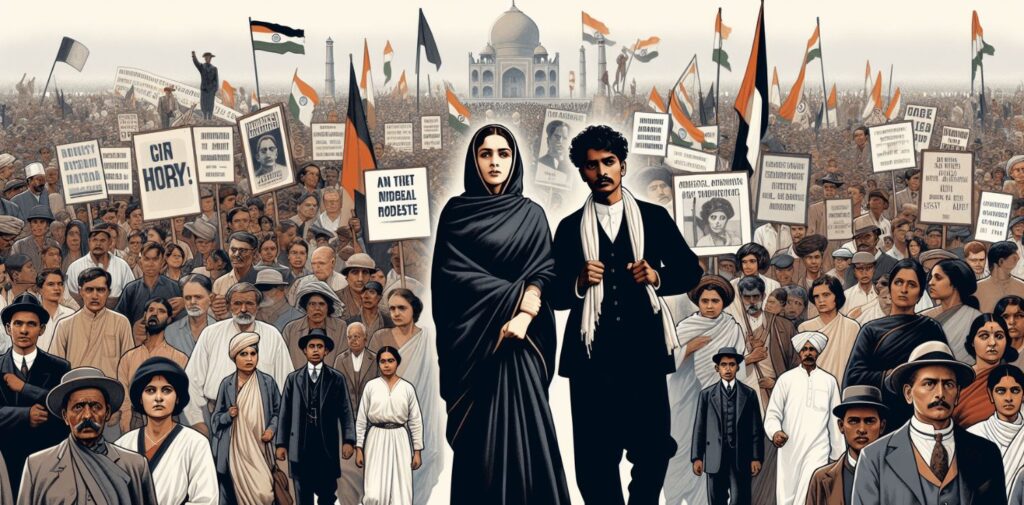The Indian press played a crucial role in the struggle for India’s independence from British colonial rule. From the early days of British control to the time of independence in 1947, the press became an essential tool in spreading nationalist ideas and mobilizing people across the country. Newspapers, magazines, and pamphlets became vehicles for expressing political ideas, voicing discontent, and rallying support for independence.
Through their power to influence public opinion and challenge colonial rule, Indian newspapers and journals helped create a sense of unity and national consciousness among Indians. The press not only raised awareness about the injustices of British rule but also provided a platform for revolutionary ideas and brought together people from all walks of life. Here’s we will explore the Role of Indian Press in Mobilizing Nationalist Sentiments.
1. Introduction of Nationalist Ideas and Ideologies
The rise of the Indian press coincided with the beginning of the nationalist movement. Newspapers like The Hindu, Amrit Bazar Patrika, and Kesari were among the first to highlight the problems created by British rule, such as economic exploitation, social inequality, and the lack of political rights. These newspapers were instrumental in spreading the ideas of prominent leaders like Dadabhai Naoroji, Bal Gangadhar Tilak, Lala Lajpat Rai, and Bipin Chandra Pal, who emphasized the need for self-rule and independence.
In the early stages, the Indian press helped in the promotion of concepts like Swaraj (self-rule) and Swadeshi (the use of Indian-made goods). The press played a key role in presenting these ideas to the masses, making them accessible to the common people. Newspapers and journals often discussed India’s rich heritage and civilization, which inspired pride among Indians and motivated them to resist foreign rule.

2. Shaping Public Opinion and Raising Awareness
The press in India helped to raise awareness about the injustices being carried out by the British. Reports of famines, poverty, and the discriminatory policies of the British government were frequently published, which highlighted the negative impact of colonialism on India. By reporting on the economic drain, social exploitation, and the deprivation of basic rights, the press created widespread disillusionment with British rule.
Moreover, the press also educated people about their rights and encouraged them to participate in political activities. Leaders like Bal Gangadhar Tilak used newspapers to communicate their message of resistance. Tilak, in particular, used his newspaper Kesari to rally the masses against the British. His bold and unapologetic writings gave people the courage to challenge British policies. The press thus became an effective medium through which people were educated about their rights and the need for collective action.
3. The Role of Regional and Vernacular Newspapers
While English-language newspapers played a significant role in the nationalist movement, regional and vernacular newspapers made a huge impact as well. The use of regional languages helped make nationalist ideas more accessible to a wider audience. Newspapers like Swadeshi and Hindustan in Hindi, Desh Bandhu in Bengali, and Pratap in Marathi helped spread the nationalist message to rural areas, where the majority of the population lived.
These newspapers not only discussed national issues but also took up local grievances and made the connection between local issues and the broader national movement. For example, newspapers in the vernacular languages covered issues like the exploitation of peasants, the ill-treatment of workers, and the impact of colonial economic policies on local industries. This made people from various regions feel connected to the national cause.

4. Spreading the Message of Non-Cooperation and Civil Disobedience
One of the most important roles played by the press was in mobilizing people for the Non-Cooperation Movement (1920-22) and the Civil Disobedience Movement (1930-34), led by Mahatma Gandhi. Newspapers and journals became platforms for leaders like Gandhi, Jawaharlal Nehru, and Subhas Chandra Bose to communicate their ideas and strategies to the public.
In 1920, the Non-Cooperation Movement was launched as a direct response to the Jallianwala Bagh massacre and the British government’s refusal to address Indian grievances. The press played a significant role in spreading the message of non-cooperation with the British government. They encouraged people to boycott British goods, reject British education, and refuse to work for the British administration. This united people across the country in a common cause, and the press helped in organizing protests, strikes, and other forms of resistance.
Similarly, in the 1930s, when Gandhi launched the Civil Disobedience Movement, the press again became an important tool in spreading the message. Gandhi’s call for the Salt March, where he and his followers walked 240 miles to the coastal town of Dandi to make salt, was widely publicized through newspapers. Reports of the march and the subsequent protests made headlines across the country and helped rally more people to the cause.
5. Encouraging Cultural Nationalism
Along with political ideas, the press also played an important role in promoting cultural nationalism. Many nationalist leaders believed that in order to achieve political independence, Indians had to revive their cultural identity and pride. The press played a crucial role in promoting this cultural revival.
Newspapers and journals frequently published articles about India’s ancient history, culture, literature, and art. They highlighted the contributions of Indian philosophers, kings, and warriors, and brought to light India’s rich traditions that had been suppressed by colonial rule. This cultural renaissance made people feel proud of their heritage and gave them the confidence to demand political freedom.
6. Bringing Together Various Sections of Society
The Indian press helped bridge the gap between different sections of society, uniting people from various regions, castes, and communities in the struggle for independence. The press provided a common platform where people could discuss their shared struggles and work together toward a common goal.
During the independence movement, the Indian press became an important unifying force. The press also highlighted issues such as untouchability and the exploitation of women, which were often neglected in mainstream politics. Social reformers like Jyotirao Phule and B.R. Ambedkar used the press to challenge the caste system and demand equal rights for lower-caste people and women. By addressing these social issues, the press helped create a broader base for the nationalist movement and encouraged the participation of various marginalized groups in the struggle for freedom.

7. Government Crackdowns and Censorship
The British government was aware of the power of the press in mobilizing nationalist sentiments, and as the nationalist movement gained momentum, the government began to impose strict censorship on the press. Newspapers that supported the freedom movement were frequently banned or heavily censored. Journalists and editors were arrested, and publications that were critical of British rule were shut down.
Despite these attempts to stifle dissent, the press continued to be an important voice of resistance. Even when banned, underground publications emerged to keep the nationalist spirit alive. These publications played a vital role in keeping the flame of independence burning, especially during times of repression.
Conclusion: Role of Indian Press
The Indian press played a pivotal role in shaping the nationalist sentiments that eventually led to India’s independence in 1947. Through the dissemination of ideas, the mobilization of people, and the encouragement of active resistance against colonial rule, newspapers and journals helped build a united front for independence. They educated people, spread the message of non-cooperation and civil disobedience, and brought attention to the social and cultural aspects of nationalism.
While facing immense challenges, including censorship and repression by the British government, the press remained resilient in its role as a powerful tool for political and social change. The Indian press not only helped to organize resistance against colonial rule but also played a key role in uniting the diverse population of India in their common struggle for freedom.
Today, the legacy of the Indian press in mobilizing nationalist sentiments continues to inspire journalists and media in their pursuit of truth, justice, and freedom.




